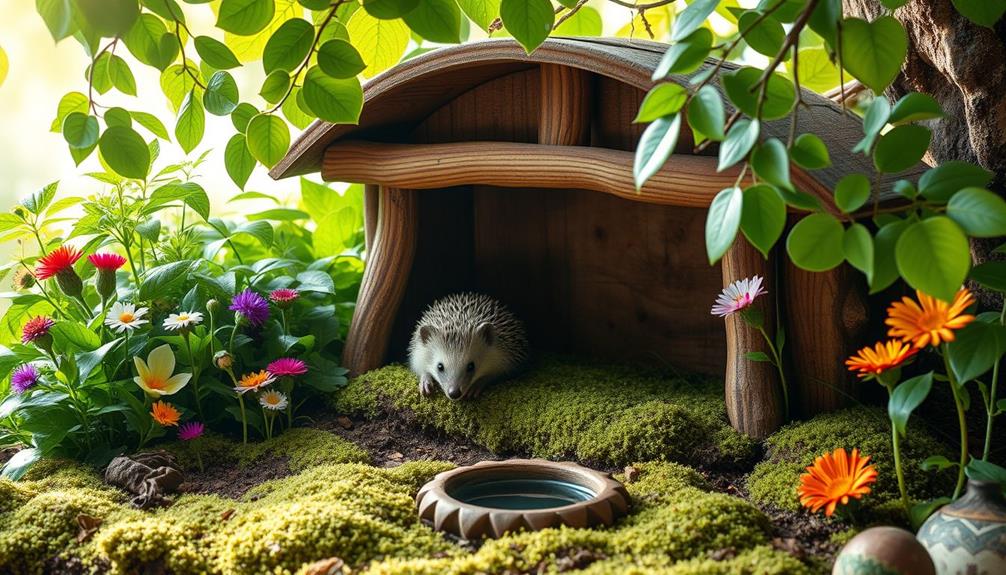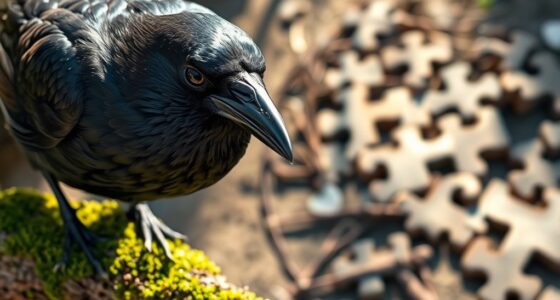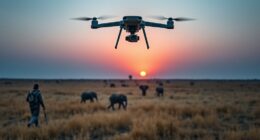The friendship between species showcases the incredible capacity for compassion, cooperation, and playfulness. Animals like a dog nursing a kitten or a giraffe befriending an ostrich defy expectation. These bonds often lead to protective instincts and cooperative behaviors that enhance survival. Such interspecies relationships can also offer physiological benefits, like reducing stress. There's so much more to discover about these unique connections and their impact on our understanding of animal behavior and well-being.
Key Takeaways
- Interspecies friendships showcase nurturing instincts, as seen in animals like Anjana the chimp caring for tiger cubs and a dog nursing a kitten.
- Animals engage in playful interactions, forming bonds that defy natural instincts, like Safi the dog playing with Wister the donkey.
- Protective behaviors across species highlight compassion, such as a deer guarding a goose's nest and a pig assisting a blind cow.
- Positive interspecies interactions release oxytocin, enhancing bonding and reducing stress, contributing to better health and longevity in both animals and humans.
- Unique friendships, like a cat adopting a chick, illustrate empathy and challenge traditional views on predator-prey dynamics.
The Bonds of Parenting Across Species
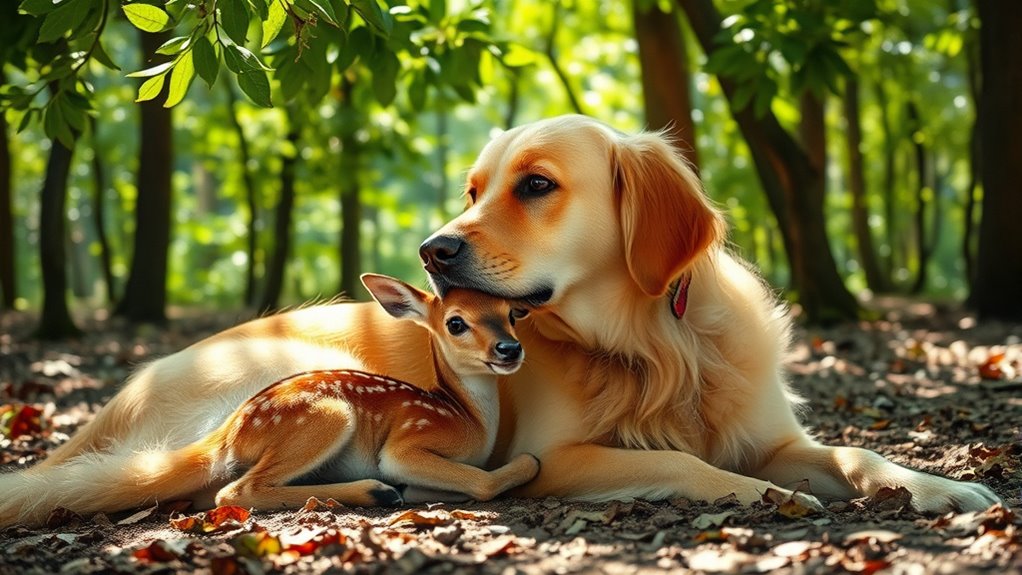
While many people believe that nurturing instincts are exclusive to one's own kind, the animal kingdom reveals a surprising truth: parenting bonds can flourish across species.
The animal kingdom surprises us, showing that nurturing instincts can thrive across species, defying biological boundaries.
You might be amazed to learn about Anjana, the chimpanzee who cared for two white tiger cubs. Their story showcases the instinctual drive to nurture beyond biological limits.
In Montana, a skunk named Peanut became a surrogate sibling to Annabelle, a lion cub, proving that animal friendships can defy expectations.
Birds, like cardinals and blackbirds, often raise chicks from different species, emphasizing that parental care knows no boundaries.
Even a mother dog has been seen nursing a kitten alongside her pups, highlighting the compassion that exists across various animal species. This behavior reflects the foraging instincts that drive animals to seek nourishment and care for young, regardless of species.
Playful Interactions: Joy Beyond Boundaries
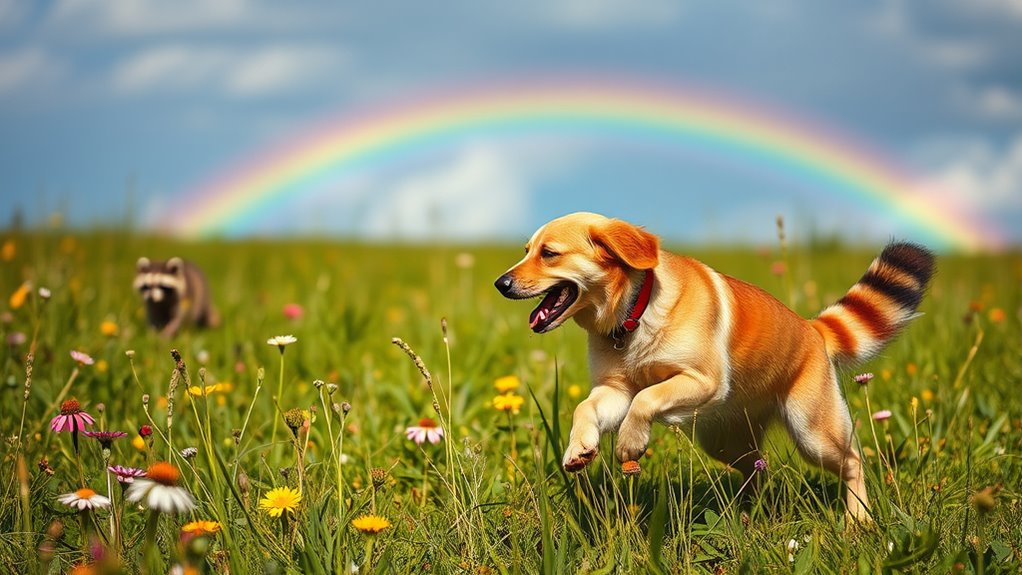
You'll be amazed at the unlikely friendships that form between different species, as animals find joy in each other's company.
Whether it's a dog kicking a soccer ball with a deer or a wolf racing with goats, these playful interactions show how fun can bridge even the widest gaps.
These moments highlight the bonding that occurs when animals engage in shared activities, proving that joy knows no boundaries.
Unlikely Animal Playmates
As animals navigate their environments, they often forge unexpected friendships that defy species boundaries, showcasing the joy found in playful interactions.
You might be surprised to see a German shepherd named Safi frolicking with a donkey named Wister or a giraffe named Bea forming an inseparable bond with an ostrich named Wilma at a Florida sanctuary.
At the San Diego Zoo, a timber wolf enjoys playful races with two goats, proving that social animals can overcome their instincts.
Even a dog and a deer can be spotted kicking a soccer ball together, highlighting their unlikely animal camaraderie.
Viral videos of these friendships, like a cat adopting a chicken chick, capture the diverse range of joyful interactions across species.
Shared Joyful Activities
When animals engage in playful activities together, they often reveal a profound sense of joy that transcends species boundaries.
Take Safi, the German shepherd, and Wister, the donkey; their bond shows how shared joyful activities can bridge gaps between different species.
In a Florida sanctuary, Bea the giraffe and Wilma the ostrich became inseparable playmates, highlighting the beauty of animal friendships.
At the San Diego Zoo, a timber wolf raced with two goats, proving that joy can flourish even among natural enemies.
You can even find dogs and deer kicking a soccer ball around, showcasing the healthy competition and fun that arises from interspecies play.
These moments remind us that joy knows no boundaries in the animal kingdom.
Bonding Through Fun
Countless instances of playful interactions among animals reveal how bonds can form across species.
Take Safi, the German shepherd, and Wister, the donkey, who find joy in each other's company while playing together.
At a sanctuary in Florida, Bea the giraffe and Wilma the ostrich display an inseparable friendship through their playful antics.
Similarly, at the San Diego Zoo, a timber wolf and two goats showcase their unique bond by racing and resting together.
You can even spot a dog and a deer playing soccer, illustrating how competition fosters friendships.
Viral videos of unlikely pairs, like a badger and coyote, capture the essence of interspecies joy, reminding us that fun knows no boundaries in the animal kingdom.
Unlikely Protectors: Acts of Defense in Nature
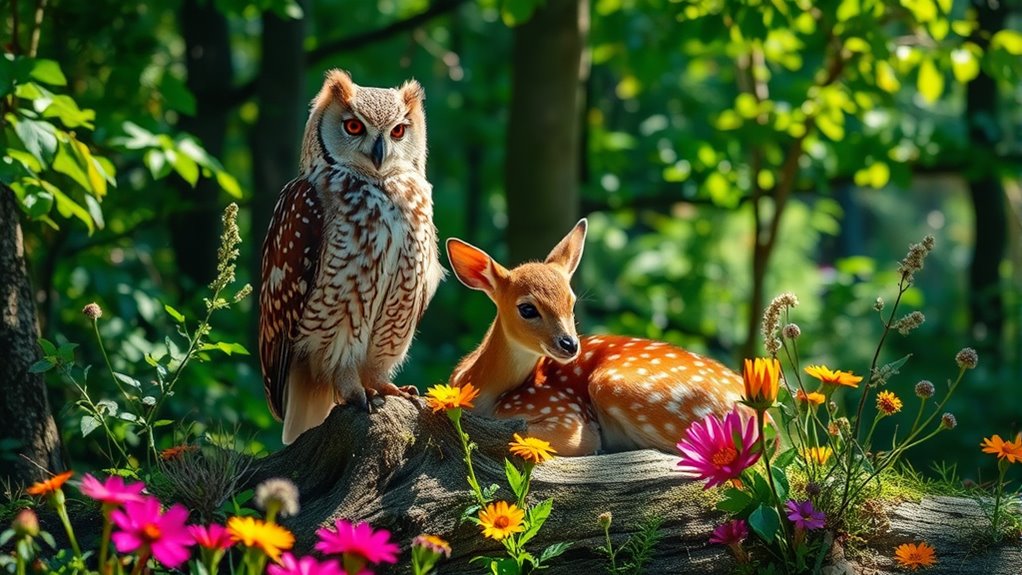
You might be surprised by the protective instincts animals show for each other, even across species.
From a deer guarding a goose nest to a pig guiding a blind cow, these acts of defense reveal a remarkable bond.
Let's explore some incredible examples of unlikely allies stepping up as guardians in nature.
Interspecies Defense Examples
Though it might seem unlikely, acts of defense between different species reveal a remarkable depth of compassion and instinct in the animal kingdom.
For instance, a deer once stood guard over a Canadian goose nest in a busy cemetery, showcasing the protective nature of interspecies friendships.
Similarly, a frog selflessly allowed a drowning rat to ride on its back, saving it from danger.
In another instance, Lulu, a guide pig, led a blind cow named Baby to food, exemplifying how species can assist one another.
A goose fiercely defended a sick Shetland pony from humans, illustrating the strong bonds that can form despite differences.
Even whales and dolphins have been known to rescue various creatures, highlighting altruistic behavior in nature.
Guardianship Among Unlikely Allies
While it might surprise you, animals often exhibit remarkable guardianship across species, forming bonds that defy conventional expectations.
Take, for example, a deer standing guard over a Canadian goose nest in a busy cemetery, showcasing protective instincts.
Then there's Lulu, a guide pig helping a blind cow named Baby find food, demonstrating the role of unlikely animal guardianship.
You might even recall the brave goose that defended a sick Shetland pony from humans, emphasizing the lengths social animals will go to protect their friends.
In a stunning act of compassion, a frog let a drowning rat ride on its back to escape danger, proving that guardianship knows no boundaries.
Even whales and dolphins assist various creatures in peril, highlighting their protective nature.
Cooperation for Survival: Provisioning Partnerships

In the wild, many animals form unexpected alliances that enhance their chances of survival. These partnerships illustrate the power of cooperation in nature, helping species thrive together.
- Coyotes and badgers hunt together, capturing a third more ground squirrels.
- Magpies remove ticks from moose and elk, preventing severe health issues.
- Clark's nutcracker birds rely on whitebark pine seeds, aiding the trees' growth.
- Honey badgers collaborate with honeyguide birds to find beehives.
- Ostriches and zebras protect each other from predators, combining their strengths.
These provisioning partnerships show how cooperation can lead to mutual benefits, allowing diverse species to flourish in their environments.
Perplexing Friendships: Breaking Instinctual Norms

Cooperation in the animal kingdom often leads to surprising alliances that enhance survival, but some interspecies friendships defy expectations entirely. You might find it fascinating how different species can form bonds that challenge their natural instincts. For instance, a cat named Snowy adopted a chick, showcasing a bond between predator and prey. Similarly, a tiger in a Siberian zoo befriended a goat instead of hunting it.
Here's a table highlighting these perplexing friendships:
| Species 1 | Species 2 | Unique Interaction |
|---|---|---|
| Rufous Woodpecker | Ants | Eggs laid in nests ignored by ants |
| Cat | Chicken | Adoption after a fox attack |
| Tiger | Goat | Friendship in a zoo setting |
These examples remind us that social connections can transcend species boundaries.
Evidence of Animal Friendships in the Wild

As you observe the natural world, you'll find that evidence of animal friendships unfolds in surprising ways. From the playful interactions captured in viral videos to the intricate social structures of the animal kingdom, these connections are fascinating.
- Badgers and coyotes forming unlikely friendships
- Male dolphins choosing foraging partners with similar styles
- Elephants greeting known individuals, showing recognition
- Primates engaging in grooming to strengthen bonds
- Rooks grooming select flock members, indicating social ties
These examples highlight how various species create bonds, emphasizing the importance of companionship for survival and social dynamics.
Such friendships not only enhance their lives but also reveal the rich tapestry of relationships that exists beyond human understanding in the wild.
Physiological Benefits of Interspecies Relationships
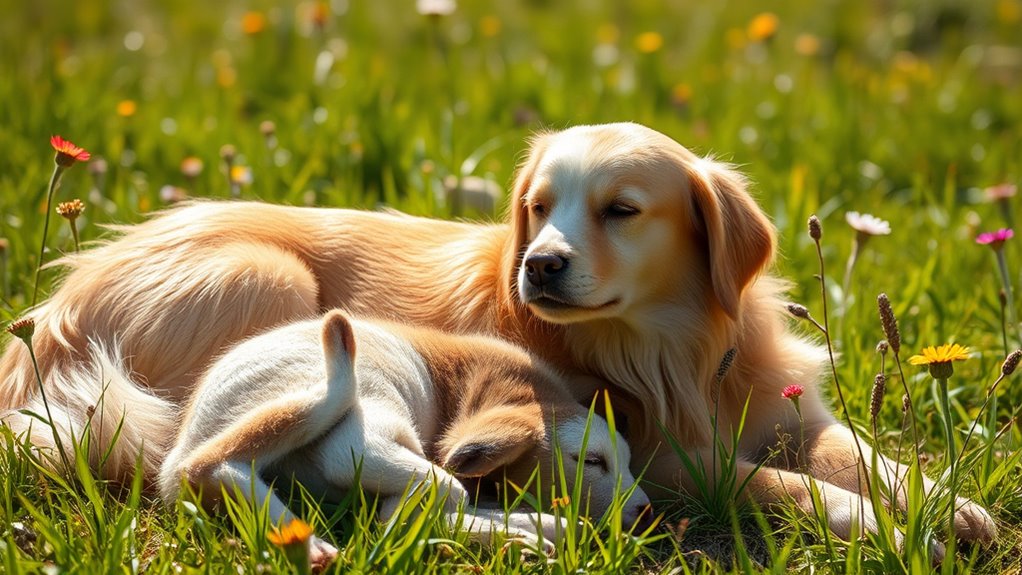
Interspecies friendships can lead to remarkable physiological benefits you mightn't expect.
When animals engage in grooming or positive interactions, they release oxytocin, which strengthens their bonds and reduces stress.
These connections not only enhance their well-being but can also improve their overall health and longevity.
Oxytocin and Bonding
When animals engage in positive social interactions, such as grooming or playing, they trigger the release of oxytocin, often called the "love hormone." This hormone enhances bonding not just within species but also between different ones, fostering trust and attachment.
- Oxytocin boosts feelings of connection and safety.
- Grooming behaviors increase oxytocin levels considerably.
- Strong bonds improve overall health in both animals and humans.
- Oxytocin-mediated friendships contribute to species' survival and reproductive success.
- Positive interactions can lead to lower stress levels.
These physiological benefits underline how oxytocin plays an essential role in interspecies relationships.
Stress Reduction Benefits
The bond formed through positive interactions between different species offers considerable stress reduction benefits. When you witness or engage in these friendships, you may notice lower cortisol levels, leading to better overall health for the animals involved.
Grooming behaviors and companionship release oxytocin, enhancing feelings of bonding and reducing anxiety. On social media, countless videos showcase these heartwarming interspecies friendships, highlighting their calming effects.
Studies show that strong social connections, even across species, correlate with longer lifespans and improved immune function. By fostering these unique relationships, animals can experience comfort and security that greatly mitigates stress-related behaviors, promoting a sense of well-being that's just as crucial for you as it's for them.
Social Structures and the Importance of Friendship

While strong social structures often emerge within animal communities, the significance of friendship can't be overstated. These bonds contribute greatly to survival and reproductive success.
Consider these aspects of social friendships:
- Enhanced resource sharing, like killer whales pooling food.
- Greater reproductive success in elephants and dolphins with tight-knit groups.
- Hyenas thriving in larger networks for better resource access.
- Risk-taking behaviors that showcase deep social bonds.
- Self-sacrifice in vampire bats, where food is shared among friends.
Friendship strengthens social structures, allowing animals to achieve more together than alone. By fostering cooperation and mutual support, these relationships play an essential role in their overall survival and well-being, highlighting the intricate connections within the animal kingdom.
Evolutionary Insights Into Animal Bonds

Understanding the evolutionary insights into animal bonds reveals how deeply rooted these connections are in the fabric of social behavior.
Take the relationship between badgers and coyotes, for instance. These two species demonstrate that cooperation can arise from evolutionary necessity, leading to enhanced survival rates.
Evidence shows that strong social ties among animals, like those seen in primates and elephants, promote longevity and lower stress. This highlights the evolutionary advantages of companionship.
Neurochemistry, particularly the release of oxytocin during positive interactions, plays a pivotal role in forming these bonds.
The Educational Value of Studying Animal Friendships

Studying animal friendships opens a window into the complexities of social behavior across species. By examining these unique bonds, you can gain valuable insights into various aspects of communication and interaction.
Here are some educational benefits of exploring animal friendships:
- Enhances understanding of empathy and companionship
- Offers evolutionary perspectives on social bonds
- Serves as effective teaching tools in psychology and biology
- Informs conservation efforts and animal welfare practices
- Engages a broad audience, fostering interest in animal behavior
These educational initiatives, like videos showcasing unlikely animal friendships, can spark curiosity and appreciation for the natural world.
Understanding animal friendships enriches your knowledge and highlights the importance of biodiversity in our ecosystems.
Frequently Asked Questions
What Is the Friendship Between Man and Animal?
Friendship between you and animals often forms through shared experiences and emotional connections.
You might find joy in the loyalty of a dog or the soothing presence of a cat. Whether it's bonding with a pet or caring for a wild animal, these relationships can enhance your life, providing companionship and reducing stress.
Your interactions foster trust and affection, reflecting a deep, mutual understanding that transcends species, enriching both your life and theirs.
Are Interspecies Relationships Possible?
You might think it's impossible, but interspecies relationships are real and fascinating.
Imagine a dog nurturing a kitten or a fox and cat playing together—these examples show that bonds can form across species.
You'll find that animals often break traditional boundaries, demonstrating friendship in unexpected ways.
These connections can lead to mutual benefits, enhancing survival and reducing stress.
What Animal Is Known for Friendship?
When you think of animals known for friendship, dolphins come to mind.
They're social creatures that form strong bonds with each other, often seen playing or helping injured members of their pods.
Elephants also stand out; they display deep emotional connections, mourning lost companions and caring for each other's young.
Even dogs, with their loyalty and affection, are celebrated for their friendships, proving that many animals thrive on connection and companionship.
What Is an Unusual Friendship Between Two Animals?
When it comes to unusual friendships, think of a beagle and a pig.
You'd never expect these two to bond, yet they do! The beagle takes on a nurturing role, caring for the piglets like their own.
It's a delightful twist on nature's script, proving that love and companionship can break traditional boundaries.
This heartwarming connection challenges your perceptions and shows that friendship knows no species—it's all about the heart.
Conclusion
In the wild, a lioness might adopt an orphaned antelope, showing that friendship knows no bounds. Just like the lioness and antelope, you can find connections in the most unexpected places. These interspecies bonds remind us that friendship transcends differences and instinct. As you observe these remarkable relationships, remember they're not just fascinating; they teach us about empathy, cooperation, and the beauty of connection in a world often defined by separation.





